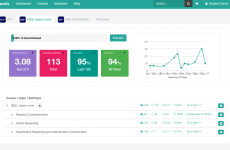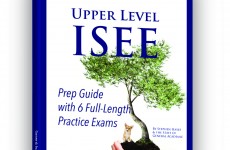The High School Placement Test (HSPT)
Scholastic Testing Service’s HSPT is an admissions test for entry into Catholic High Schools. The HSPT contains five multiple-choice sections: Verbal, Quantitative Skills, Reading, Mathematics, and Language Skills. Depending on the school, the HSPT might also feature an optional section covering Science, Mechanical Aptitude or Catholic Religion. The optional test is not included in the composite score from the HSPT and not every school chooses to use the optional test. Schools that require the optional test might use the score to determine a student’s placement in particular courses such as honors and advanced classes.
Structure of the HSPT
| Test Section | Time Limit | Content Area / Skills | # Questions |
| Verbal Skills | 16 Minutes | Verbal Analogies | 10 Questions |
| Synonyms | 15 Questions | ||
| Logic | 10 Questions | ||
| Verbal Classifications | 16 Questions | ||
| Antonyms | 9 Questions | ||
| TOTAL | 60 Questions | ||
| Quantitative Skills | 30 Minutes | Number Series | 18 Questions |
| Geometric Comparison | 9 Questions | ||
| Non-Geometric Comparison | 8 Questions | ||
| Number Manipulation | 17 Questions | ||
| TOTAL | 52 Questions | ||
| Reading | 25 Minutes | Comprehension | 40 Questions |
| Vocabulary | 22 Questions | ||
| TOTAL | 62 Questions | ||
| Mathematics | 45 Minutes | Concepts | 24 Questions |
| Problem-Solving | 40 Questions | ||
| TOTAL | 64 Questions | ||
| Language Skills | 25 Minutes | Punctuation and Capitalization | 12 Questions |
| Usage | 28 Questions | ||
| Spelling | 10 Questions | ||
| Composition | 10 Questions | ||
| TOTAL | 60 Questions |
What to Expect on the HSPT
The Verbal Skills section tests a student’s ability to answer verbal analogy, synonym, logic, verbal classification, and antonym questions. Verbal analogies address whether a student understands a relationship between two words (ex. Tree is to limb as human is to arm—whole to part). The Synonym and Antonym questions test the student’s knowledge of vocabulary, including the definitions of the answer choices. In verbal classifications, students are asked to identify which of one or four answer choices does not belong with the others. In logic questions, students are given three statements and students must determine if the third statement is true, false, or uncertain based on the truth of the first two statements.
The Quantitative Skills section tests a student’s ability to answer number series, geometric comparison, non-geometric comparison, and number manipulation questions. Number series questions test a student’s ability to determine the relationship between numbers, letters, and/or symbols in a sequence. Geometric and Non-Geometric Comparison questions ask students to compare three figures/shapes (geometric) or numerical/mathematical expressions (non-geometric) and determine the relationship between them. In number manipulation questions, students must use multiple mathematical steps to solve each problem (ex. What number is 3 more than 1/3 of 200).
The Reading section contains passages that test a student’s comprehension of ideas, themes, tone, and the author’s intent. The student must be able to quickly grasp the main idea of the passage, understand the supporting details within the passage, and must demonstrate knowledge of vocabulary within the context of the passage. The passages will cover a wide variety of subjects, including science, history, literature, and societal topics.
The Mathematics section tests a student’s ability to answer questions concerning arithmetic, algebra, and geometry appropriate to eighth grade students. In arithmetic, students must demonstrate familiarity with the number line, order of operations, multiplication, division, addition, subtraction, fractions, decimals, percentages and other aspects of basic math. Students will solve questions involving algebraic equations and concepts such as absolute value. In geometry, students will need to show their understanding of area of plane figures, perimeter of plan figures, volume of solid figures, angles, and coordinate geometry (graphing). Students will also be solving word problems that feature rate, time, distance, and work problems (two or more workers performing at different rates).
The Language Skills section tests a student’s knowledge of grammar and writing mechanics. Students will answer questions involving spelling, punctuation and capitalization, principles of grammar, and language composition and expression. Topic development questions will either give the student a topic sentence and the student must choose a second and third sentence that best develops that topic or the student will be given a title and the student must choose a topic sentence or relative sentence that belongs under that title. Sentence appropriateness questions ask a student to identify whether a sentence belongs with the others or what the best placement for a sentence would be.
HSPT Highlights
- 1 point is awarded for each correct answer in all sections
- There are no deductions for incorrect answers in all sections (answer all questions!)
- The student is not allowed a calculator for the math sections
- Students are not provided scratch paper—all work is to be done on the test booklet
- The student will take the HSPT at the Catholic high school they would most prefer to attend, though the student may list other Catholic high schools to be sent the student’s HSPT scores
- The HSPT features multiple scores:
- Raw score – the total number of correct answers in each section
- Scaled score – each raw score is converted into a scaled score of 200 to 800
- Like the ISEE, Scholastic Testing Service uses various versions of the HSPT to test students, and the scaled scores mean the same thing across all versions
- Percentile rank – the student’s standing in comparison to the national sample
- Each section receives a percentile rank
- Scholastic Testing Service also provides a local percentile rank
- Each percentile rank is followed by a stanine, which represents the percentile rank in a score of 1 to 9
- Cognitive Skills – collection of scores and a total from the Verbal and Quantitative Skills sections; includes the CSQ, scaled scores, percentile ranks, and stanines
- Basic Skills – collection of scores and a total from the Reading, Mathematics, and Language Skills sections; includes scaled scores, percentile ranks, and stanines
- Composite – combined scaled score, percentile rank, and stanine from all five sections (does not include the optional test)
- Optional Test – national percentile rank of the optional test: Mechanical Aptitude, Science, or Catholic Religion
- Cognitive Skills Quotient (CSQ) – similar to an IQ score with an operational range of 55 to 145, this score reflects the student’s learning potential and is based on age
- Grade Equivalent (GE) – demonstrates the student’s aptitude in terms of scoring similarly to a student in a higher grade (ex. GE of 11.5 means the student is scoring as an 11th grader in the fifth month of the academic year would)
Further Reading
Excerpted from General Academic’s publication, “Houston Private & Select Public Schools: Survey, Analysis, and Research, 3rd Edition.”
















Pingback: Overview of the Independent School Entrance Exam (ISEE)